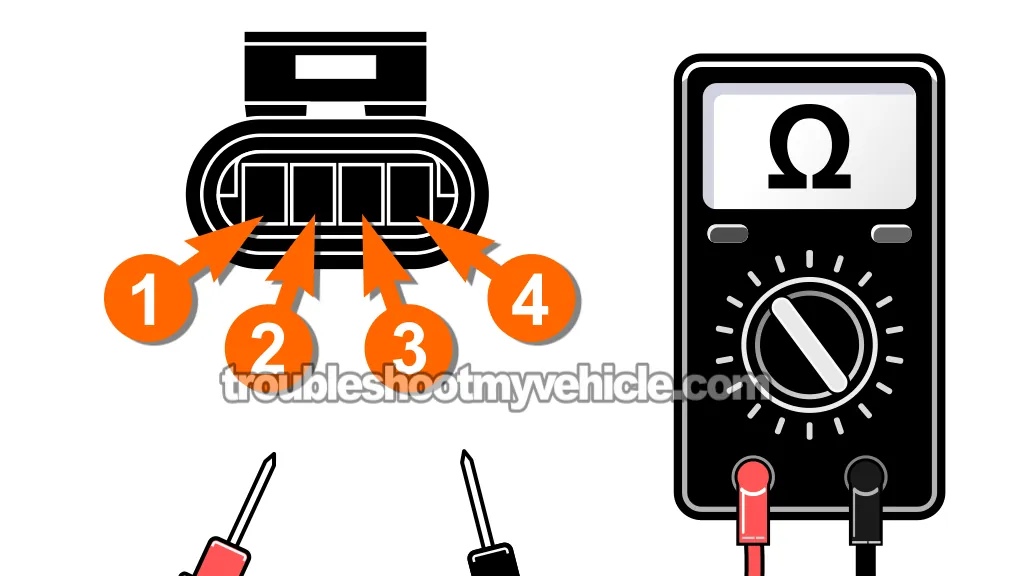TEST 3: Checking The IAC Valve Wires For A Short To Ground

This test is designed to find out if any of the IAC valve wires are unintentionally Grounded. Just like in TEST 2, each wire coming from the IAC connector should not only be isolated from each other —it should also show no connection to Ground.
A short to Ground typically happens when the wire's insulation becomes damaged or worn, allowing the bare copper to touch a metal surface such as the engine block or another Grounded component.
This kind of fault will definitely interrupt the PCM's control over the IAC valve and trigger the check engine light (CEL) with a Code 25: Idle Air Control (IAC) Circuit.
IMPORTANT: Before beginning this test, disconnect the negative (-) battery cable. This ensures the battery doesn't interfere with your multimeter readings or cause accidental shorts.
Alright, let's check for any shorts to Ground in the IAC wiring:
- 1
Disconnect the negative (-) battery cable from the battery terminal.
You'll use the free end of this cable as your Ground reference during testing. - 2
Unplug both the IAC valve connector and the PCM's 60-pin connector.
NOTE: This isolates the wiring so you're testing only the engine wiring harness —with no influence from these components. - 3
Set your multimeter to Ohms mode.
- 4
Place one probe of your multimeter on Terminal 1 of the IAC connector. Use the other probe to touch the loose negative battery cable —your Ground point.
- 5
Check the multimeter for continuity (5 Ohms or less).
- 6
The meter should show infinite resistance (no continuity) usually indicated by the letters OL.
If you see a low resistance reading —typically 5 Ohms or less— that means the wire is Grounding out somewhere along the circuit. - 7
Repeat this procedure for Terminals 2, 3, and 4, checking each one individually against Ground.
Let's evaluate your test results:
CASE 1: No continuity —meter shows infinite resistance on all four wires. This is what we need to see and confirms none of the IAC wires are shorted to Ground.
You're ready to move on to: TEST 4: Check IAC Valve Stepper Motor Resistance (From FI computer Connector).
CASE 2: Continuity (5 Ohms or less) found on one or more terminals. That tells you there's an unwanted Ground contact somewhere in the engine wiring harness between the IAC connector and the computer.
Carefully inspect the engine wiring harness, especially around areas where it may be rubbing against brackets, sharp surfaces, or hot engine components.
Repair or replace any damaged wiring. For some practical tips on this type of repair, see: How To Repair Shorted IAC Wires (Real-World Fix).
TEST 4: Checking IAC Valve Stepper Motor Resistance (From FI Computer Connector)

OK, so up to now, your tests have eliminated the usual wiring faults:
- The connector and all four IAC wires checked out fine (TEST 1).
- No internal shorts between any IAC circuits (TEST 2).
- No wires Grounding out (TEST 3).
Now it's time to evaluate the IAC valve itself —specifically, its two stepper motors that move the pintle in and out to regulate idle airflow.
Each of these motors is operated through a dedicated pair of wires connected directly to the PCM. In this step, you'll measure the resistance across the correct pins at the PCM's 60-pin connector to test the health of each motor.
On a properly functioning IAC valve, you'll typically see around 35 Ohms of resistance for each motor coil —though values between 8 and 10 Ohms are also commonly reported. These aren't official factory numbers, but they're considered normal for working IAC valves.
What matters most is that both readings are similar. If one coil reads drastically different —or you see infinite resistance (an open-circuit) or close to zero Ohms (a short)— then that motor has failed, and the IAC valve needs to be replaced.
IMPORTANT WARNING: Be extremely cautious when testing the female terminals inside the FI computer's 60-pin connector. Never force standard multimeter probes into these small round terminals —they're too large and can permanently deform or damage the connectors. This kind of damage can cause weak electrical contact, erratic behavior, or a total circuit failure. Always use properly sized test probes made for terminal pin testing. Handle this step with precision and care.
OK, here's the step-by-step:
- 1
Make sure the negative (-) battery cable is still disconnected before proceeding.
- 2
Disconnect the PCM from its 60-pin wiring connector.
- 3
Reconnect the IAC valve to its 4-wire connector.
- 4
Set your multimeter to Ohms (Ω) mode.
- 5
To test Stepper Motor 1:
Place your multimeter probes on terminals 39 and 60 of the FI computer connector.
You should see a reading around 35 Ohms. Some IAC valves may show between 8 to 10 Ohms, which is still normal. - 6
To test Stepper Motor 2:
Move the probes to terminals 40 and 59 on the same connector.
Expect a resistance reading in the same general range —around 35 Ohms, or possibly 8 to 10 Ohms. - 7
Both motors should return nearly identical resistance values. Large differences between them indicate a problem.
If your meter shows either an open-circuit (infinite resistance) or a short-circuit (near-zero resistance), that means one of the stepper motor windings has failed, and the IAC valve will need to be replaced.
Here's how to interpret your results:
CASE 1: Both resistance values are close to the indicated Ohms value. That's a good sign —the internal motor coils are intact.
If idle problems persist and Code 25 doesn't want to go away, it could be due to mechanical issues like a sticky pintle or carbon deposits inside the valve.
There's also the possibility (although very rare) that the PCM is bad. See: What If The PCM Itself Is Bad?
CASE 2: One or both readings show infinite resistance. That's a sign of a broken internal winding —an open-circuit— in the IAC valve. The IAC valve will need to be replaced.
CASE 3: One or both readings are close to zero Ohms. This indicates a shorted coil, which renders the valve non-functional. Replacement is the only fix.
What If The PCM Itself Is Bad?
Although rare, a malfunctioning Powertrain Control Module (PCM) —specifically, a failure within the IAC driver circuits —can sometimes be the root cause of a Code 25.
But, I want to be very clear and emphasize: this kind of failure is highly unusual.
What makes it challenging is that there's no direct way to test the IAC driver circuits inside the computer using a scan tool or multimeter.
These driver circuits are embedded solid-state components. If one of them fails, the computer might stop sending proper signals to the IAC valve, resulting in idle problems like stalling, erratic or elevated RPMs, and eventually a Code 25 fault.
A bad PCM should only be suspected after you've ruled out all other likely causes.
Be sure the following items have passed inspection before considering computer failure:
- All four IAC wires are free of shorts —to each other or to Ground.
- Resistance readings on both IAC valve stepper motors are within normal range.
- The IAC connector is in good condition —no corrosion, broken terminals, or loose fit.
- The intake manifold gasket is sealing correctly —as in no vacuum leaks.
- No vacuum leaks are present near the throttle body area.
- The throttle plates and bores are clean and moving freely —no sticking.
- The idle stop screw hasn't been tampered with or misadjusted.
If all of these components are functioning correctly, yet idle issues persist and Code 25 keeps returning, it may be time to suspect an internal computer fault.
The only way to confirm this is to install a known-good PCM and monitor whether the issue disappears. If the symptoms vanish, the original computer was definitely the problem.
Still, it bears repeating: true PCM failures are uncommon. Start by troubleshooting the wiring, IAC valve, and mechanical components thoroughly before considering a PCM replacement.
How To Repair Shorted IAC Wires (Real-World Fix)
If you've confirmed that two IAC wires are shorted —and the damaged portion is hidden deep within the wiring harness, out of view or hard to access— don't panic.
You don't need to tear apart the entire harness or trace the wire inch by inch. That's not how it's usually handled in real-world repairs.
The practical and reliable solution is to bypass the faulty section by installing a new wire. It's a straightforward method and, when done correctly, provides a durable and lasting fix.
Here's how to go about it:
- Cut the affected wire(s) at least 3 to 4 inches away from the IAC connector to ensure you're working beyond the problem area.
- Make a similar cut near the FI computer connector, choosing a section of clean, undamaged wire.
- Splice in new wire that matches the original gauge and insulation type. Strip the ends and solder the connections for a solid, dependable joint.
- Skip the butt connectors. While they may seem convenient, they will loosen over time due to engine vibration, leading to intermittent or total failure.
- Once soldered, use heat shrink tubing or high-quality electrical tape to insulate and protect the repair from moisture and wear.
Although replacing the entire wiring harness would be the textbook fix, it's almost never required. A clean, well-executed splice like this will be a a solid IAC circuit issue solution.
More 3.9L V6 Dodge Ram Pickup Tutorials
I've written several more tutorials for the V6 Dodge Ram pickups that may be of interest to you that you can find in this index:
Here's a sample of the tutorials you'll find in the index:
- How To Test The TPS (1992-1996 3.9L V6 Dodge Ram Pickup).
- How To Test The MAP Sensor (1992-1996 3.9L V6 Dodge Ram Pickup).
- How To Test The Fuel Pump (1992-2001 3.9L V6 Dodge Ram Pickup).
- How To Test The Intake Air Temp (IAT) Sensor (1992-1997 3.9L V6 Dodge Ram Pickup).

If this info saved the day, buy me a beer!

